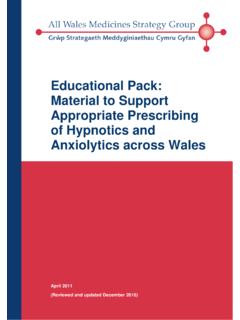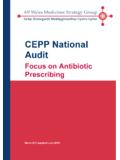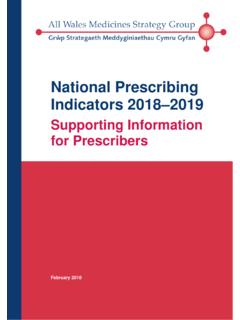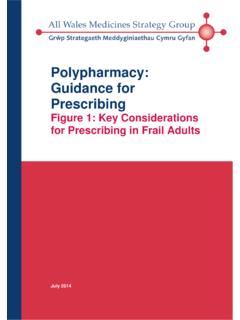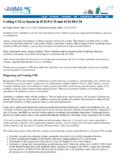Transcription of Warfarin Monitoring June 2012 - AWMSG
1 Warfarin Monitoring Warfarin Monitoring BACKGROUND Approximately of the population are currently taking anticoagulation therapy at any one time. Following the publication of the National Institute for Health and Clinical Excellence (NICE) clinical guideline CG36, there is clear evidence that treating selected patients with Warfarin reduces the risks associated with atrial fibrillation (AF) significantly, thus reducing mortality and morbidity (see Appendix 1)3,4. Approximately 60% of patients taking Warfarin are being treated for stroke prevention associated with AF. Other common indications include treatment of venous and arterial thromboembolism, as well as prophylaxis after insertion of prosthetic heart valves.
2 Whilst Warfarin is a very effective drug in these conditions, it is associated with significant adverse events, particularly haemorrhage. There is an increased risk of associated morbidity, mortality and hospital admissions. There is a risk per annum of fatal haemorrhage, and a 4% chance per annum of significant haemorrhage. These risks increase with co-morbidities, age and international normalised ratios (INRs) over 3, and it is therefore essential to have safeguards in place to prevent harm2,5. Similarly, it is important for patients to understand the potential risks and benefits so that they may make an informed choice about management.
3 The haemorrhagic side effects may be related to the INR level, which measures the delay in the clotting of the blood caused by the Warfarin . While normal INR is 1, the specific range of INR values depends on the disease and the clinical conditions. Warfarin has a narrow therapeutic index and a long half-life (40 hours), as well as significant interpatient variability; therefore regular INR blood Monitoring tests are required to guide dosing. Warfarin Monitoring aims to stabilise the INR within set limits to help prevent serious side effects, while maximising effective treatment. As the INR increases above 3, there is an exponential rise in the risk of haemorrhage6.
4 However, if the INR is sub-therapeutic, this is also potentially dangerous as there is an increased thrombotic risk, particularly in the first six weeks of treatment for thromboembolism and long-term in the population with prosthetic heart valves. The Department of Health Care Closer to Home initiative, in the white paper Our health, our care, our say 7, also supports management of patients closer to home. Patient choice is important, and many patients prefer to be seen and managed locally to their home, supporting this initiative. For these reasons, it is essential that personnel involved in dosing patients have a full understanding of the pharmacology of Warfarin and potential complications, and that systems are robust in order to minimise risks.
5 Warfarin Monitoring RECOMMENDED CLARIFICATIONS AND CHANGES TO CURRENT SERVICE PROVISION Initiation Anticoagulation may be initiated in primary care for AF using a slow-loading regime. Other indications, such as prosthetic heart valves and arterial and venous thromboembolism (VTE), are normally initiated and stabilised in secondary care Prior to commencing anticoagulation, a risk assessment should be undertaken and documented (see Appendix 2), in addition to baseline INR, clotting screen, full blood count, urea and electrolytes and liver function tests. Use a slow-loading regimen for patients who do not require rapid anticoagulation for AF.
6 This is safe and achieves therapeutic anticoagulation within 3 4 weeks for the majority of patients. There are several evidence-based protocols; , prescribe 3 mg Warfarin daily for five days, then check INR on the fifth day. Practices should ensure that patients records clearly indicate the location of Monitoring . The following read-codes apply: Anticoagulation Monitoring secondary care {66QC} Anticoagulation Monitoring primary care {66QD} Self- Monitoring of INR {66QE} Avoid Warfarin (use low molecular weight heparin [LMWH]) in patients with cancer-associated VTE. Patients with active malignancy have a significantly increased risk of bleeding with Warfarin .
7 In addition, patients with cancer-associated VTE are at high risk of recurrence, and LMWH has been shown to be more effective than Warfarin for the first six months of treatment8. The All Wales Medicines Strategy Group ( AWMSG ) have recommended that treatment doses of LMWH prescribed for VTE in cancer patients ( patients undergoing cancer therapy or those who have metastatic disease) are suitable for shared care for up to six months of treatment9. Cancer patients requiring anticoagulation for AF10: The All Wales Prescribing Advisory Group (AWPAG) Anticoagulation National Audit results suggest that 1 2% of practice populations are taking Warfarin , and approximately 60% of these will be for AF.
8 If patients subsequently develop cancer, their risk of thromboembolism and bleeding will change. Given the heterogonous nature of patients with cancer, their risks and benefits for continued anticoagulation should be assessed individually and reviewed periodically. KEY POINTS Prior to commencing anticoagulation, undertake and document risk assessment Use a slow-loading regimen for patients who do not require rapid anticoagulation for AF Avoid Warfarin (use LMWH) in patients with cancer-associated VTE Warfarin Monitoring Newly diagnosed patients Prescribers should have a documented discussion with the patient regarding the risks, benefits and implications of long-term Warfarin treatment.
9 Decision aids should be used where possible.; for example: Consideration should be given to providing the patient with a Warfarin information DVD; St George s Living With Warfarin (available at: ), when starting therapy, and periodically thereafter. Review The need for continuation of therapy is reviewed regularly with an annual risk assessment. The following read-code applies: Annual risk assessment {66Q2} There should be clearly defined commissioning arrangements for an annual medication review (see section : Gold standard annual medication review).
10 This should normally be undertaken in primary care for all patients on the register, and for all levels of enhanced service. Dosing practices should use computer dosing software systems. The National Patient Safety Agency (NPSA) states that There is evidence that anticoagulant dosing software helps to maintain the INR levels within the therapeutic range, extend the time between INR tests and effectively manage anticoagulant records facilitating service audit 2. Computer dosing has been shown to significantly reduce the risk of bleeding and thromboembolic events and, overall, is a more cost-effective option to manual dosing11. The management of non-attenders, recall facility, annual review and audit features, as well as serious incident review, are all important in ensuring delivery of a safe system to patients.




